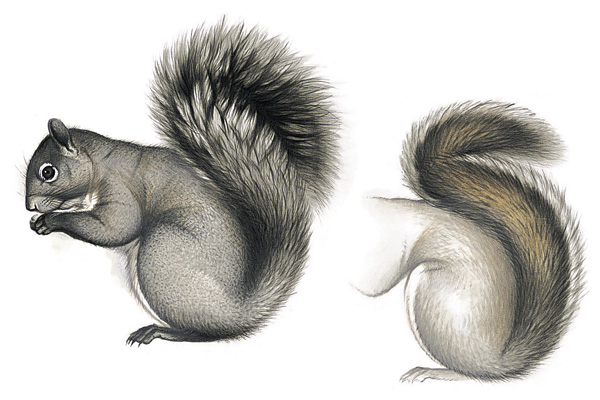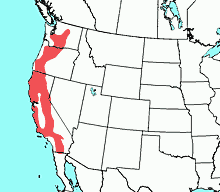 Painting by Todd Zalewski from Kays and
Wilson's Mammals of North America, ę Princeton
University Press (2002)
Painting by Todd Zalewski from Kays and
Wilson's Mammals of North America, ę Princeton
University Press (2002)
|
|
Description |
The western grey
squirrel ranges from about 18 inches to 24 inches in total
length with the body and the tail. Their weight varies from 350
to 950 grams.
Sciurus griseus has silver grey fur on its back and
a white underside. It has a long bushy tail which is the same
silver grey color. Their tail may also have black in it.
Sciurus griseus has large
ears without tufts.
The western grey
squirrel sheds its fur once in the late spring and again in
early fall. The fur on the tail is only shed during the spring
molting.
Length:
Range: 510-770
mm
Weight:
Range: 500-950 g
|
|
Range Map |
|
Taxonomic Hierarchy |

Western grey squirrels lives on the west coast of the
United States. Western grey squirrels can be found in
Washington, Oregon, California, and in a very small part of
Nevada. |
|
Kingdom: |
Animalia |
|
Phylum: |
Chordata |
|
Subphylum: |
Vertebrata |
|
Class: |
Mammalia |
|
Subclass: |
Theria |
|
Infraclass: |
Eutheria |
|
Order: |
Rodentia |
|
Suborder: |
Sciuromorpha |
|
Family: |
Sciuridae |
|
Subfamily: |
Sciurinae |
|
Genus: |
Sciurus |
|
Species: |
Sciurus griseus |
|
|
Reproduction &
Life Cycle |
Sexual maturity of Sciurus griseus is
reached at 10 to 11 months. When Sciurus
griseus is approximately one year old it
will begin breeding. When a female is in
estrus the vulva becomes pink and enlarged.
When a male is sexually active the scrotum
turns black from its original pinkish gray
color. Breeding takes place once a year in
the late spring. There are betwee 3 and 5
young per litter. Younger females generally
have smaller litters than older females. The
gestation period averages 43 days. Young are
born without hair and with closed eyes and
ears. The head and feet of young are large
compared to the rest of the body. They are
weaned at approximately 10 weeks.
|
|
Conservation Status |
|
Western grey squirrels are a
United States species of concern, but are not
currently listed as threatened or endangered under
the U.S. Endangered Species Act. In late 2002 the
Washington subspecies, S.
griseus griseus was proposed for listing
as an endangered species. In Washington they are
considered threatened at the state level, in Oregon
they are considered a state sensitive species. |
|
|
Habitat |
Western grey squirrels
are found in woodlands and coniferous
forests. They can be found at elevations up
to 2500 meters.
|
|
Behavior |
|
Western grey squirrels live in
hollow trees or in nests they build called dreys.
These are made of sticks and lined and insulated
with softer materials such as moss.
Sciurus griseus is diurnal. While
out of the nest Sciurus griseus spends its time
grooming, exploring, gathering food, and resting.
Grooming can last from 3 to 15 minutes, with most of
the time being spent on the head area. Western grey
squirrels have a home range size of 0.5 to 7
hectares. Males generally have a larger home range
than females. While exploring Sciurus griseus
gathers food. Food they don't eat or take back to
the nest is buried around their home range. The
buried food is called a cache and is later found by
their good sense of smell. Caches are usually used
in the colder months when food is scarce.
Western grey squirrels do not
hibernate but much less time is spent outside during
the colder winter months.
Sciurus griseus is
non-territorial except when the female is in estrus.
When threatened western grey
squirrels make barking sounds while flicking their
tails and stamping their feet. |
|
Food |
Western grey squirrel's main source of food
depends largely upon local habitat
characteristics. Those that live in coniferous
forests feed primarily on seeds of pinecones.
Those that live in hardwood forests feed largely
on nuts and acorns.
Sciurus griseus is also known to eat
berries, fungus, bark, sap, and insects. It
opens hard seeds and nuts using its incisors.
Western grey squirrels will feed on the ground
as well as in trees.
|
|
|
Other Names |
Sound |
- Gwi˝ver gris ar c'horn˘g (Breton)
- Columbian Gray Squirrel (English)
- Silver Gray Squirrel (English)
- Western Gray Squirrel (English)
- Ardilla gris (Spanish)
- Sciurus griseus (Spanish)
|
They use a variety of sounds to
communicate, including barks, chatters, distress screams,
and high-pitched whines during mating. |
|
|
|
|
Sources used to
Construct this Page: |
- Alden, P., F. Heath, R. Keen, A. Leventer, W.
Zomlefer. 1998. National Audubon society field guide to
California. New York: Alfred A. Knopf.
- Ingles, L. 1947. Mammals of the Pacific States.
Stanford, California: Stanford University Press.
- Linsdale, J. 1946. The California ground squirrel.
Berkeley and Los Angeles: University of California
press.
- MacClintock, D. 1970. Squirrels of North America.
New York and Toronto: Van Nostrand Reinhold Company.
- Whitaker, Jr., J. 1980. National Audubon society
field guide to North American mammals. New York: Alfred
A. Knopf.
- Boellstorff, D., D. Owings, M. Penedo, M. Hersek.
1994. Reproductive behaviour and multiple paternity of
California ground squirrels. Animal Behaviour, 47(5):
1057-1064.
- Cato, F. 2003. "San Diego Natural history Museum
Field Guide: Spermophilus beecheyi" (On-line). Accessed
June 17, 2003 at http://www.sdnhm.org/fieldguide/mammals/sper-bee.html
.
- Evans, F., R. Holdenried. 1943. A population study
of the Beechey ground squirrel in Central California.
Journal of Mammalogy, 24(2): 231-260.
|
|